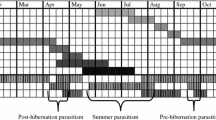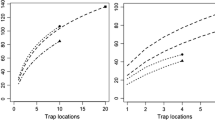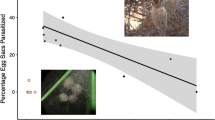Abstract
Despite extensive research on parasitoid-prey interactions and especially the effects of heterogeneity in parasitism on stability, sources of heterogeneity other than prey density have been little investigated. This research examines parasitism rates by three parasitoid species in relationship to prey density and habitat spatial pattern. The herbivore Itame andersoni (Geometridae) inhabits a subdivided habitat created by patches of its host plant, Dryas drummondii, in the Wrangell Mountains of Alaska. Dryas colonizes glacial moraines and spreads clonally to form distinct patches. Habitat subdivision occurs both on the patch scale and on the larger spatial scale of sites due to patchy successional patterns. Itame is attacked by three parasitoids: an ichneumonid wasp (Campoletis sp.), a braconid wasp (Aleiodes n. sp.), and the tachinid fly (Phyrxe pecosensis). I performed a large survey study at five distinct sites and censused Itame density and parasitism rates in 206 plant patches for 1–3 years. Parasitism rates varied with both plant patch size and isolation and also between sites, and the highest rates of overall parasitism were in the smallest patches. However, the effects of both small- and large-scale heterogeneity on parasitism differed for the three parasitoid species. There was weak evidence that Itame density was positively correlated with parasitism for the braconid and tachinid at the patch scale, but density effects differed for different patch sizes, patch isolations, and sites. At the site scale, there was no evidence of positive, but some indication of negative density-dependent parasitism. These patterns do not appear to be driven by negative interactions between the three parasitoid species, but reflect, rather, individual differences in habitat use and response to prey density. Finally, there was no evidence that parasitism strongly impacted the population dynamics of Itame. These results demonstrate the importance of considering habitat pattern when examining spatial heterogeneity of parasitism and the impacts of parasitoids.
Similar content being viewed by others
Author information
Authors and Affiliations
Additional information
Received: 3 June 1999 / Accepted: 4 October 1999
Rights and permissions
About this article
Cite this article
Doak, P. The effects of plant dispersion and prey density on parasitism rates in a naturally patchy habitat. Oecologia 122, 556–567 (2000). https://doi.org/10.1007/s004420050979
Issue Date:
DOI: https://doi.org/10.1007/s004420050979




